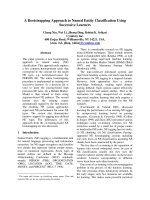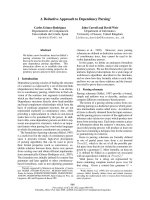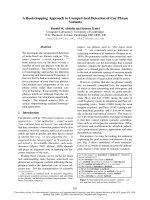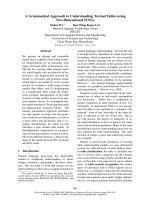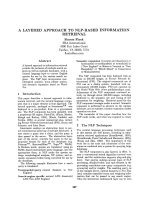Báo cáo khoa học: "A Computational Approach to Zero-pronouns in Spanish" doc
Bạn đang xem bản rút gọn của tài liệu. Xem và tải ngay bản đầy đủ của tài liệu tại đây (102.92 KB, 7 trang )
A Computational Approach to Zero-pronouns in
Spanish
Antonio Ferrández and Jesús Peral
Dept. Languages and Information Systems, University of Alicante
Carretera San Vicente S/N
03080 ALICANTE, Spain
{antonio, jperal}@dlsi.ua.es
Abstract
In this paper, a computational approach for
resolving zero-pronouns in Spanish texts is
proposed. Our approach has been evaluated
with partial parsing of the text and the
results obtained show that these pronouns
can be resolved using similar techniques that
those used for pronominal anaphora.
Compared to other well-known baselines on
pronominal anaphora resolution, the results
obtained with our approach have been
consistently better than the rest.
Introduction
In this paper, we focus specifically on the
resolution of a linguistic problem for Spanish
texts, from the computational point of view:
zero-pronouns
in the “subject” grammatical
position. Therefore, the aim of this paper is not
to present a new theory regarding zero-
pronouns, but to show that other algorithms,
which have been previously applied to the
computational resolution of other kinds of
pronoun, can also be applied to resolve zero-
pronouns.
The resolution of these pronouns is
implemented in the computational system called
Slot Unification Parser for Anaphora resolution
(SUPAR)
. This system, which was presented in
Ferrández et al. (1999), resolves anaphora in
both English and Spanish texts. It is a modular
system and currently it is being used for
Machine Translation and Question Answering,
in which this kind of pronoun is very important
to solve due to its high frequency in Spanish
texts as this paper will show.
We are focussing on zero-pronouns in
Spanish texts, although they also appear in other
languages, such as Japanese, Italian and
Chinese. In English texts, this sort of pronoun
occurs far less frequently, as the use of subject
pronouns is generally compulsory in the
language. While in other languages, zero-
pronouns may appear in either the subject´s or
the object´s grammatical position, (e.g.
Japanese), in Spanish texts, zero-pronouns only
appear in the position of the subject.
In the following section, we present a
summary of the present state-of-the-art for zero-
pronouns resolution. This is followed by a
description of the process for the detection and
resolution of zero-pronouns. Finally, we present
the results we have obtained with our approach.
1 Background
Zero-pronouns have already been studied in
other languages, such as Japanese,
(e.g. Nakaiwa
and Shirai (1996)). They have not yet been
studied in Spanish texts, however. Among the
work done for their resolution in different
languages, nevertheless, there are several points
that are common for Spanish. The first point is
that they must first be located in the text, and
then resolved. Another common point among,
they all employ different kinds of knowledge
(e.g. morphologic or syntactic) for their
resolution. Some of these works are based on the
Centering Theory (e.g. Okumura and Tamura
(1996)). Other works, however, distinguish
between
restrictions
and
preferences
(e.g.
Lappin and Leass (1994)).
Restrictions
tend to
be absolute and, therefore, discard any possible
antecedents,
whereas
preferences
tend to be
relative and require the use of additional criteria,
i.e. heuristics that are not always satisfied by all
anaphors. Our anaphora resolution approach
belongs to the second group.
In computational processing, semantic and
domain information is computationally
inefficient when compared to other kinds of
knowledge. Consequently, current anaphora
resolution methods rely mainly on restrictions
and preference heuristics, which employ
information originating from morpho-syntactic
or shallow semantic analysis, (see Mitkov
(1998) for example). Such approaches,
nevertheless, perform notably well. Lappin and
Leass (1994) describe an algorithm for
pronominal anaphora resolution that achieves a
high rate of correct analyses (85%). Their
approach, however, operates almost exclusively
on syntactic information. More recently,
Kennedy and Boguraev (1996) propose an
algorithm for anaphora resolution that is actually
a modified and extended version of the one
developed by Lappin and Leass (1994). It works
from a POS tagger output and achieves an
accuracy rate of 75%.
2 Detecting zero-pronouns
In order to detect zero-pronouns, the sentences
should be divided into clauses since the subject
could only appear between the clause
constituents. After that, a noun-phrase (NP) or a
pronoun that agrees in person and number with
the clause verb is sought, unless the verb is
imperative or impersonal.
As we are also working on unrestricted texts
to which partial parsing is applied, zero-
pronouns must also be detected when we do not
dispose of full syntactic information. In
Ferrández et al. (1998), a partial parsing strategy
that provides all the necessary information for
resolving anaphora is presented. That study
shows that only the following constituents were
necessary for anaphora resolution: co-ordinated
prepositional and noun phrases, pronouns,
conjunctions and verbs, regardless of the order
in which they appear in the text.
H1 Let us assume that the beginning of a new clause has
been found when a verb is parsed and a
free conjunction
is subsequently parsed.
When partial parsing is carried out, one
problem that arises is to detect the different
clauses of a sentence. Another problem is how to
detect the zero-pronoun, i.e. the omission of the
subject from each clause. With regard to the first
problem, the heuristic H1 is applied to identify a
new clause.
(1)John y Jane llegaron tarde al trabajo porque
∅∅
1
se
durmieron
(John and Jane were late for work
because
[they]
∅∅
over-slept)
1
The symbol
∅
will always show the position of the
In this particular case, a
free conjunction
does not imply conjunctions
2
that join co-
ordinated noun and prepositional phrases. It
refers, here, to conjunctions that are parsed in
our partial parsing scheme. For instance, in
sentence (1), the following sequence of
constituents is parsed:
np(John and Jane), verb(were), freeWord
3
(late), pp(for
work), conj(because), pron(they), verb(over-slept )
Since the free conjunction
porque (because)
has been parsed after the verb
llegaron (were)
,
the new clause with a new verb
durmieron
(over-slept)
can be detected.
With reference to the problem about
detecting the omission of the subject from each
clause with partial parsing, it is solved by
searching through the clause constituents that
appear before the verb. In sentence (1), we can
verify that the first verb,
llegaron (were)
, does
not have its subject omitted since there appears a
np(John and Jane)
. However, there is a zero-
pronoun,
(they)
∅
, for the second verb
durmieron
(over-slept)
.
(2) Pedro
j
vio a Ana
k
en el parque.
∅
k
Estaba muy guapa
(Peter
j
saw Ann
k
in the park. [She]
∅
k
was very beautiful)
When the zero-pronoun is detected, our
computational system inserts the pronoun in the
position in which it has been omitted. This
pronoun will be resolved in the following
module of anaphora resolution. Person and
number information is obtained from the clause
verb.
Sometimes in Spanish, gender information
of the pronoun can be obtained when the verb is
copulative. For example, in sentence (2), the
verb
estaba (was)
is copulative, so that its
subject must agree in gender and number with
its object whenever the object can have either a
masculine or a feminine linguistic form (
guapo:
masc, guapa: fem
). We can therefore obtain
information about its gender from the object,
guapa (beautiful
in its feminine form
)
which
automatically assigns it to the feminine gender
so the omitted pronoun would have to be
she
rather than
he
. Gender information can be
obtained from the object of the verb with partial
omitted pronoun.
2
For example, it would include punctuation marks
such as a semicolon.
3
The
free words
consist of constituents that are not
covered by this partial parsing (e.g. adverbs).
parsing as we simply have to search for a NP on
the right of the verb.
3 Zero-pronoun resolution
In this module, anaphors (i.e. anaphoric
expressions such as pronominal references or
zero-pronouns) are treated from left to right as
they appear in the sentence, since, at the
detection of any kind of anaphor, the appropriate
set of restrictions and preferences begins to run.
The number of previous sentences considered
in the resolution of an anaphora is determined by
the kind of anaphora itself. This feature was
arrived at following an in depth study of Spanish
texts. For pronouns and zero-pronouns, the
antecedents in the four previous sentences, are
considered.
The following restrictions are first applied to
the list of candidates: person and number
agreement, c-command
4
constraints and
semantic consistency
5
. This list is sorted by
proximity to the anaphor. Next, if after applying
the restrictions there is still more than one
candidate, the preferences are then applied, with
the degree of importance shown in Figure 1.
This sequence of preferences (from 1 to 10)
stops whenever only one candidate remains after
having applied a given preference. If after all the
preferences have been applied there is still more
than one candidate left, the most repeated
candidates
6
in the text are then extracted from
the list, and if there is still more than one
candidate, then the candidates that have
appeared most frequently with the verb of the
anaphor are extracted from the previous list.
Finally, if after having applied all the previous
preferences, there is still more than one
candidate left, the first candidate of the resulting
list (the closest to the anaphor) is selected.
The set of constraints and preferences
required for Spanish pronominal anaphora
presents two basic differences: a) zero-pronoun
resolution has the restriction of agreement only
4
The usage of c-command restrictions on partial
parsing is presented in Ferrández et. al. (1998).
5
Semantic knowledge is only used when working on
restricted texts.
6
Here, we mean that we first obtain the maximum
number of repetitions for an antecedent in the
remaining list. After that, we extract the antecedents
that have this value of repetition from the list.
in person and number, (whereas pronominal
anaphora resolution requires gender agreement
as well), and b) a different set of preferences.
1) Candidates in the same sentence as the
anaphor.
2) Candidates in the previous sentence.
3) Preference for candidates in the same
sentence as the anaphor and those that
have been the solution of a zero-pronoun in
the same sentence as the anaphor.
4) Preference for proper nouns or indefinite
NPs.
5) Preference for proper nouns.
6) Candidates that have been repeated more
than once in the text.
7) Candidates that have appeared with the
verb of the anaphor more than once.
8) Preference for noun phrases that are not
included in a prepositional phrase or those
that are connected to an Indirect Object.
9) Candidates in the same position as the
anaphor, with reference to the verb (before
the verb).
10) If the zero-pronoun has gender
information, those candidates that agree in
gender.
Figure 1. Anaphora resolution preferences.
The main difference between the two sets of
preferences is the use of two new preferences in
our algorithm: Nos. 3 and 10. Preference 10 is
the last preference since the POS tagger does not
indicate whether the object has both masculine
and feminine linguistic forms
7
(i.e. information
obtained from the object when the verb is
copulative). Gender information must therefore
be considered a preference rather than a
restriction. Another interesting fact is that
syntactic parallelism (Preference No. 9)
continues to be one of the last preferences,
which emphasizes the unique problem that arises
in Spanish texts, in which syntactic structure is
quite flexible (unlike English).
4 Evaluation
4.1 Experiments accomplished
Our computational system (SUPAR) has been
trained with a handmade corpus
8
with 106 zero-
7
For example in:
Peter es un genio (Peter is a
genius)
, the tagger does not indicate that the object
does not have both masculine and feminine linguistic
forms. Therefore, a feminine subject would use the
same form:
Jane es un genio (Jane is a genius)
.
Consequently, although the tagger says that the verb,
es (is
), is copulative, and the object,
un genio (a
genius)
is masculine, this gender could not be used as
a restriction for the zero-pronoun in the following
sentence:
∅
Es un genio
.
8
This corpus has been provided by our colleagues in
pronouns. This training has mainly supposed the
improvement of the set of preferences, i.e. the
optimum order of preferences in order to obtain
the best results. After that, we have carried out a
blind evaluation on unrestricted texts.
Specifically, SUPAR has been run on two
different Spanish corpora: a) a part of the
Spanish version of The Blue Book corpus, which
contains the handbook of the International
Telecommunications Union CCITT, published
in English, French and Spanish, and
automatically tagged by the Xerox tagger, and b)
a part of the Lexesp corpus, which contains
Spanish texts from different genres and authors.
These texts are taken mainly from newspapers,
and are automatically tagged by a different
tagger than that of The Blue Book. The part of
the Lexesp corpus that we processed contains ten
different stories related by a sole narrator,
although they were written by different authors.
Having worked with different genres and
disparate authors, we feel that the applicability
of our proposal to other sorts of texts is assured.
In Figure 2, a brief description of these corpora
is given. In these corpora, partial parsing of the
text with no semantic information has been used.
Number
of words
Number of
sentences
Words per
sentence
Lexesp corpus Text 1
972 38 25.6
Text 2
999 55 18.2
Text 3
935 34 27.5
Text 4
994 36 27.6
Text 5
940 67 14
Text 6
957 34 28.1
Text 7
1025 59 17.4
Text 8
981 40 24.5
Text 9
961 36 26.7
Text 10
982 32 30.7
The Blue Book corpus 15,571 509 30.6
Figure 2. Description of the unrestricted
corpora used in the evaluation.
4.2 Evaluating the detection of zero-
pronouns
To achieve this sort of evaluation, several
different tasks may be considered. Each verb
must first be detected. This task is easily
the University of Alicante, which were required to
propose sentences with zero-pronouns.
accomplished since both corpora have been
previously tagged and manually reviewed. No
errors are therefore expected on verb detection.
Therefore, a recall
9
rate of 100% is
accomplished. The second task is to classify the
verbs into two categories: a) verbs whose
subjects have been omitted, and b) verbs whose
subjects have not. The overall results on this sort
of detection are presented in Figure 3 (success
10
rate of 88% on 1,599 classified verbs, with no
significant differences seen between the
corpora). We should also remark that a success
rate of 98% has been obtained in the detection of
verbs whose subjects were omitted, whereas
only 80% was achieved for verbs whose subjects
were not. This lower success rate is justified,
however, for several reasons. One important
reason is the non-detection of impersonal verbs
by the POS tagger. This problem has been partly
resolved by heuristics such as a set of
impersonal verbs (e.g. llover (to rain)), but it has
failed in some impersonal uses of some verbs.
For example, in sentence (3), the verb es (to be)
is not usually impersonal, but it is in the
following sentence, in which SUPAR would
fail:
(3)
∅
Es hora de desayunar
([It]
∅
is time to have breakfast)
Two other reasons for the low success rate
achieved with verbs whose subjects were not
omitted are the lack of semantic information and
the inaccuracy of the grammar used. The second
reason is the ambiguity and the unavoidable
incompleteness of the grammars, which also
affects the process of clause splitting.
In Figure 3, an interesting fact can be
observed: 46% of the verbs in these corpora
have their subjects omitted. It shows quite
clearly the importance of this phenomenon in
Spanish. Furthermore, it is even more important
in narrative texts, as this figure shows: 61% with
the Lexesp corpus, compared to 26% with the
technical manual. We should also observe that
The Blue Book has no verbs in either the first or
the second person. This may be explained by the
style of the technical manual, which usually
9
By “recall rate”, we mean the number of verbs
classified, divided by the total number of verbs in the
text.
10
By “success rate”, we mean the number of verbs
successfully classified, divided by the total number of
verbs in the text.
Verbs with their subject omitted
Verbs with their subject no-omitted
First person Second person Third person First person Second person Third person
Total %
Success
Total %
Success
Total %
Success
Total %
Success
Total %
Success
Total %
Success
111 100% 42 100% 401 99% 21 81% 3 100% 328 76%
20% 7% 73% 7% 1% 92%
Lexesp
corpus
554 (61%) (success rate: 99%) 352 (39%) (success rate: 76%)
0 0% 0 0% 180 97% 0 0% 0 0% 513 82%
0% 0% 100% 0% 0% 100%
Blue
Book
corpus
180 (26%) (success rate: 97%) 513 (74%) (success rate: 82%)
734 (46%) (success rate: 98%) 865 (54%) (success rate: 80%)
Total
1,599 (success rate: 88%)
Figure 3. Results obtained in the detection of zero-pronouns.
consists of a series of isolated definitions, (i.e.
many paragraphs that are not related to one
another). This explanation is confirmed by the
relatively small number of anaphors that are
found in that corpus, as compared to the Lexesp
corpus.
We have not considered comparing our
results with those of other published works,
since, (as we have already explained in the
Background section), ours is the first study that
has been done specifically for Spanish texts, and
the designing of the detection stage depends
mainly on the structure of the language in
question. Any comparisons that might be made
concerning other languages, therefore, would
prove to be rather insignificant.
4.3 Evaluating anaphora resolution
As we have already shown in the previous
section, (Figure 3), of the 1,599 verbs classified
in these two corpora, 734 of them have zero-
pronouns. Only 581 of them, however, are in
third person and will be resolved. In Figure 4,
we present a classification of these third person
zero-pronouns, which have been conveniently
divided into three categories: cataphoric,
exophoric and anaphoric. The first category is
comprised of those whose antecedent, i.e. the
clause subject, comes after the verb. For
example, in sentence (4) the subject, a boy,
appears after the verb compró (bought).
(4)
∅
k
Compró un niño
k
en el supermercado
(A boy
k
bought
in the supermarket)
This kind of verb is quite common in
Spanish, as can be seen in this figure (49%).
This fact represents one of the main difficulties
found in resolving anaphora in Spanish: the
structure of a sentence is more flexible than in
English. These represent intonationally marked
sentences, where the subject does not occupy its
usual position in the sentence, i.e. before the
verb. Cataphoric zero-pronouns will not be
resolved in this paper, since semantic
information is needed to be able to discard all of
their antecedents and to prefer those that appear
within the same sentence and clause after the
verb. For example, sentence (5) has the same
syntactic structure than sentence (4), i.e. verb,
np, pp, where the subject function of the np can
only be distinguished from the object by means
of semantic knowledge.
(5)
∅
Compró un regalo en el supermercado
([He]
∅
bought
a present in the supermarket)
The second category consists of those zero-
pronouns whose antecedents do not appear,
linguistically, in the text (they refer to items in
the external world rather than things referred to
in the text). Finally, the third category is that of
pronouns that will be resolved by our
computational system, i.e., those whose
antecedents come before the verb: 228 zero-
pronouns. These pronouns would be equivalent
to the full pronoun he, she, it or they.
AnaphoricCataphoric Exophoric
Number Success
Lexesp
corpus
171 (42%) 56 (12%)
174 (46%)
78%
The Blue
Book corpus
113 (63%) 13 (7%) 54 (30%) 68%
Total 284 (49%) 69 (12%)
228 (39%)
75%
Figure 4. Classification of third person zero-
pronouns.
The different accuracy results are also shown
in Figure 4: A success rate of 75% was attained
for the 228 zero-pronouns. By “successful
resolutions” we mean that the solutions offered
by our system agree with the solutions offered
by two human experts.
For each zero-pronoun there is, on average,
355 candidates before the restrictions are
applied, and 11 candidates after restrictions.
Furthermore, we repeated the experiment
without applying restrictions and the success
rate was significantly reduced.
Since the results provided by other works
have been obtained on different languages, texts
and sorts of knowledge (e.g. Hobbs and Lappin
full parse the text), direct comparisons are not
possible. Therefore, in order to accomplish this
comparison, we have implemented some of
these approaches in SUPAR. Although some of
these approaches were not proposed for zero-
pronouns, we have implemented them since as
our approach they could also be applied to solve
this kind of pronoun. For example, with the
baseline presented by Hobbs (1977) an accuracy
of 49.1% was obtained, whereas, with our
system, we achieved 75% accuracy. These
results highlight the improvement accomplished
with our approach, since Hobbs´ baseline is
frequently used to compare most of the work
done on anaphora resolution
11
. The reason why
Hobbs´ algorithm works worse than ours is due
to the fact that it carries out a full parsing of the
text. Furthermore, the way to explore the
syntactic tree with Hobbs’ algorithm is not the
best one for the Spanish language since it is
nearly a free-word-order language.
Our proposal has also been compared with
the typical baseline of morphological agreement
and proximity preference, (i.e., the antecedent
11
In Tetreault (1999), for example, it is compared
with an adaptation of the Centering Theory by Grosz
et al. (1995), and Hobbs´ baseline out-performs it.
that appears closest to the anaphor is chosen
from among those that satisfy the restrictions).
The result is a 48.6% accuracy rate. Our system,
therefore, improves on this baseline as well.
Lappin and Leass (1994) has also been
implemented in our system and an accuracy of
64% was attained. Moreover, in order to
compare our proposal with Centering approach,
Functional Centering by Strube and Hahn (1999)
has also been implemented, and an accuracy of
60% was attained.
One of the improvements afforded by our
proposal is that statistical information from the
text is included with the rest of information
(syntactic, morphologic, etc.). Dagan and Itai
(1990), for example, developed a statistical
approach for pronominal anaphora, but the
information they used was simply the patterns
obtained from the previous analysis of the text.
To be able to compare our approach to that of
Dagan and Itai, and to be able to evaluate the
importance of this kind of information, our
method was applied with statistical
information
12
only. If there is more than one
candidate after applying statistical information,
preference, and then proximity preference are
applied. The results obtained were lower than
when all the preferences are applied jointly:
50.8%. These low results are due to the fact that
statistical information has been obtained from
the beginning of the text to the pronoun. A
previous training with other texts would be
necessary to obtain better results.
Regarding the success rates reported in
Ferrández et al. (1999) for pronominal
references (82.2% for Lexesp, 84% for Spanish
version of The Blue Book, and 87.3% for the
English version), are higher than our 75%
success rate for zero-pronouns. This reduction
(from 84% to 75%) is due mainly to the lack of
gender information in zero-pronouns.
Mitkov (1998) obtains a success rate of
89.7% for pronominal references, working with
English technical manuals. It should be pointed
out, however, that he used some knowledge that
was very close to the genre
13
of the text. In our
12
This statistical information consists of the number
of times that a word appears in the text and the
number of times that it appears with a verb.
13
For example, the antecedent indicator
section
heading preference,
in which if a NP occurs in the
heading of the section, part of which is the current
study, such information was not used, so we
consider our approach to be more easily
adaptable to different kinds of texts. Moreover,
Mitkov worked exclusively with technical
manuals whereas we have worked with narrative
texts as well. The difference observed is due
mainly to the greater difficulty found in
narrative texts than in technical manuals which
are generally better written. In any case, the
applicability of our proposal to different genres
of texts seems to have been well proven.
Anyway, if the order of application of the
preferences
14
is varied to each different text, an
80% overall accuracy rate is attained. This fact
implies that there is another kind of knowledge,
close to the genre and author of the text that
should be used for anaphora resolution.
Conclusion
In this paper, we have proposed the first
algorithm for the resolution of zero-pronouns in
Spanish texts. It has been incorporated into a
computational system (SUPAR). In the
evaluation, several baselines on pronominal
anaphora resolution have been implemented, and
it has achieved better results than either of them
have.
As a future project, the authors shall attempt
to evaluate the importance of semantic
information for zero-pronoun resolutions in
unrestricted texts. Such information will be
obtained from a lexical tool, (e.g.
EuroWordNet), which could be consulted
automatically. We shall also evaluate our
proposal in a Machine Translation application,
where we shall test its success rate by its
generation of the zero-pronoun in the target
language, using the algorithm described in Peral
et al. (1999).
References
Ido Dagan and Alon Itai (1990) Automatic
processing of large corpora for the resolution of
anaphora references. In
Proceedings of the 13
th
sentence, it is considered to be the preferred
candidate.
14
The difference between the individual sets of
preferences is the degree of importance of the
preferences for proper nouns and syntactic
parallelism.
International Conference on Computational
Linguistics, COLING
(Helsinki, Finland).
Antonio Ferrández, Manuel Palomar and Lidia
Moreno (1998) Anaphora resolution in unrestricted
texts with partial parsing. In
Proceedings of the 36
th
Annual Meeting of the Association for
Computational Linguistics and 17
th
International
Conference on Computational Linguistics,
COLING - ACL
(Montreal, Canada). pp. 385-391.
Antonio Ferrández, Manuel Palomar and Lidia
Moreno (1999) An empirical approach to Spanish
anaphora resolution.
To appear in Machine
Translation 14(2-3)
.
Jerry Hobbs (1977) Resolving pronoun references.
Lingua
, 44. pp. 311-338.
Cristopher Kennedy and Bran Boguraev (1996)
Anaphora for Everyone: Pronominal Anaphora
resolution without a Parser. In
Proceedings of the
16
th
International Conference on Computational
Linguistics, COLING
(Copenhagen, Denmark). pp.
113-118.
Shalom Lappin and Herb Leass (1994) An algorithm
for pronominal anaphora resolution.
Computational
Linguistics
, 20(4). pp. 535-561.
Ruslan Mitkov (1998) Robust pronoun resolution
with limited knowledge. In
Proceedings of the 36
th
Annual Meeting of the Association for
Computational Linguistics and 17
th
International
Conference on Computational Linguistics,
COLING - ACL
(Montreal, Canada). pp. 869-875.
Hiromi Nakaiwa and Satoshi Shirai (1996) Anaphora
Resolution of Japanese Zero Pronouns with Deictic
Reference. In
Proceedings of the 16
th
International
Conference on Computational Linguistics,
COLING
(Copenhagen, Denmark). pp. 812-817.
Manabu Okumura and Kouji Tamura (1996) Zero
Pronoun Resolution in Japanese Discourse Based
on Centering Theory. In
Proceedings of the 16
th
International Conference on Computational
Linguistics, COLING
(Copenhagen, Denmark). pp.
871-876.
Jesús Peral, Manuel Palomar and Antonio Ferrández
(1999) Coreference-oriented Interlingual Slot
Structure and Machine Translation. In
Proceedings
of ACL Workshop on Coreference and its
Applications
(College Park, Maryland, USA). pp.
69-76.
Michael Strube and Udo Hahn (1999) Functional
Centering – Grounding Referential Coherence in
Information Structure.
Computational Linguistics
,
25(5). pp. 309-344.
